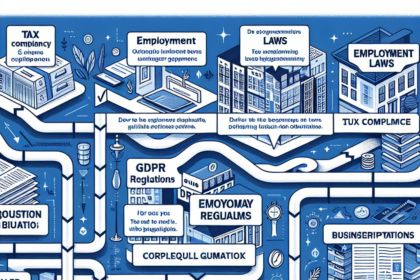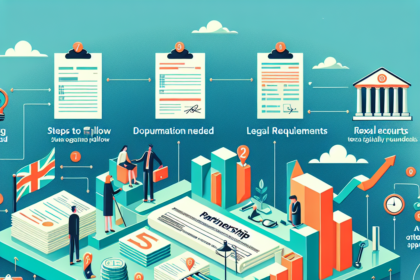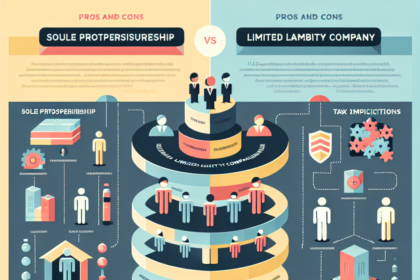Tag: Legal Entities and Structures in the UK
Introduction
Starting a business in the United Kingdom requires a thorough understanding of the various legal entities and structures available. Each structure has its own set of legal requirements, advantages, and disadvantages that can impact your business operations, tax obligations, and liability. This comprehensive guide delves into the different types of legal entities and structures in the UK, providing valuable insights to help you make informed decisions for your business.
Chapter 1: Sole Trader
1.1 Overview
A sole trader is the simplest and most common form of business structure in the UK. It is owned and operated by a single individual.
1.2 Legal Requirements
- Registration: Must register with HM Revenue & Customs (HMRC) for self-assessment tax purposes.
- Licenses and Permits: Depending on the business activity, specific licenses or permits may be required.
- Insurance: Public liability insurance is recommended, and employer’s liability insurance is required if employing staff.
1.3 Advantages
- Ease of Formation: Simple and cost-effective to set up.
- Control: Full control over business decisions.
- Tax Benefits: Simpler tax filing and lower accounting costs.
1.4 Disadvantages
- Unlimited Liability: Personal assets are at risk if the business incurs debt or legal liabilities.
- Limited Capital: Harder to raise large amounts of capital.
- Limited Life: The business does not survive the owner’s death or incapacitation.
Chapter 2: Partnership
2.1 General Partnership
Overview
A general partnership involves two or more individuals who share ownership and management responsibilities.
Legal Requirements
- Partnership Agreement: Strongly recommended to outline partners’ roles, profit-sharing, and dispute resolution.
- Registration: Register the partnership with HMRC for tax purposes.
- Licenses and Permits: Depending on the business activity, specific licenses or permits may be required.
Advantages
- Shared Resources: Combines resources and expertise of multiple partners.
- Tax Benefits: Pass-through taxation, where income is reported on partners’ personal tax returns.
Disadvantages
- Unlimited Liability: Each partner is personally liable for the business’s debts.
- Potential for Disputes: Risk of conflicts between partners.
2.2 Limited Partnership (LP)
Overview
A limited partnership includes both general and limited partners.
Legal Requirements
- Partnership Agreement: Must clearly define the roles of general and limited partners.
- Registration: Required with Companies House.
- Licenses and Permits: May be required based on business activities.
Advantages
- Limited Liability for Limited Partners: Limited partners’ liability is restricted to their investment.
- Attracts Investors: Easier to raise capital by attracting limited partners.
Disadvantages
- Complex Formation: More legal formalities than a general partnership.
- Limited Control for Limited Partners: Limited partners cannot participate in management without risking their limited liability status.
2.3 Limited Liability Partnership (LLP)
Overview
A Limited Liability Partnership (LLP) combines the benefits of a partnership with the limited liability of a company.
Legal Requirements
- Partnership Agreement: Highly recommended to outline roles and profit-sharing.
- Registration: Must register with Companies House.
- Annual Filing: Submit annual accounts and confirmation statement to Companies House.
Advantages
- Limited Liability: Partners’ personal assets are protected.
- Flexibility: Flexible management structure.
- Pass-Through Taxation: Profits are taxed as personal income of the partners.
Disadvantages
- Complexity and Cost: More paperwork and higher setup costs compared to general partnerships.
- Public Disclosure: Financial statements are publicly accessible.
Chapter 3: Limited Company
3.1 Private Limited Company (Ltd)
Overview
A Private Limited Company (Ltd) is a separate legal entity from its owners, offering limited liability protection.
Legal Requirements
- Articles of Association: Must draft and file with Companies House.
- Registration: Register the company with Companies House.
- Directors: Must have at least one director.
- Company Secretary: Not mandatory but recommended for larger companies.
- Annual Filing: Submit annual accounts and confirmation statement to Companies House.
- Corporation Tax: Register for and pay corporation tax to HMRC.
Advantages
- Limited Liability: Shareholders’ personal assets are protected.
- Separate Legal Entity: The company can own assets and incur liabilities.
- Raising Capital: Can issue shares to raise capital.
Disadvantages
- Complexity and Cost: More paperwork and higher setup costs.
- Public Disclosure: Financial statements and other details are publicly accessible.
3.2 Public Limited Company (PLC)
Overview
A Public Limited Company (PLC) is a company that can offer shares to the public and is subject to more stringent regulatory requirements.
Legal Requirements
- Minimum Share Capital: Must have a minimum share capital of £50,000.
- Articles of Association: Must draft and file with Companies House.
- Registration: Register the company with Companies House.
- Directors: Must have at least two directors.
- Company Secretary: Mandatory.
- Annual Filing: Submit annual accounts and confirmation statement to Companies House.
- Corporation Tax: Register for and pay corporation tax to HMRC.
Advantages
- Limited Liability: Shareholders’ personal assets are protected.
- Raising Capital: Can raise significant capital by offering shares to the public.
- Credibility: Generally perceived as more credible and stable.
Disadvantages
- Complexity and Cost: High setup and maintenance costs.
- Regulatory Requirements: Subject to stringent regulatory and reporting requirements.
- Public Disclosure: Financial statements and other details are publicly accessible.
Chapter 4: Community Interest Company (CIC)
4.1 Overview
A Community Interest Company (CIC) is a special type of limited company designed for social enterprises that want to use their profits and assets for the public good.
4.2 Legal Requirements
- Community Interest Statement: Must submit a statement explaining how the company will benefit the community.
- Asset Lock: Ensures that the company’s assets are used for its social objectives.
- Registration: Register the company with Companies House.
- Annual Filing: Submit annual accounts and confirmation statement to Companies House.
- Corporation Tax: Register for and pay corporation tax to HMRC.
4.3 Advantages
- Limited Liability: Shareholders’ personal assets are protected.
- Social Purpose: Clear focus on social objectives.
- Credibility: Enhanced credibility with stakeholders and investors.
4.4 Disadvantages
- Regulatory Oversight: Subject to oversight by the CIC Regulator.
- Profit Distribution: Restrictions on profit distribution to shareholders.
- Public Disclosure: Financial statements and other details are publicly accessible.
Chapter 5: Charitable Incorporated Organisation (CIO)
5.1 Overview
A Charitable Incorporated Organisation (CIO) is a legal form specifically for charities in England and Wales, providing a simpler structure than a charitable company.
5.2 Legal Requirements
- Registration: Must register with the Charity Commission.
- Governing Document: Must have a constitution that sets out the charity’s objectives and how it will be run.
- Trustees: Must have a board of trustees to manage the charity.
- Annual Filing: Submit annual accounts and an annual return to the Charity Commission.
5.3 Advantages
- Limited Liability: Trustees are protected from personal liability.
- Simplified Reporting: Less onerous reporting requirements compared to charitable companies.
- Public Trust: Increased credibility and trust with donors and stakeholders.
5.4 Disadvantages
- Regulatory Oversight: Subject to oversight by the Charity Commission.
- Restrictions: Must operate solely for charitable purposes.
- Public Disclosure: Financial statements and other details are publicly accessible.
Chapter 6: Unincorporated Association
6.1 Overview
An unincorporated association is an informal structure for a group of people who come together for a common purpose, such as a club or society.
6.2 Legal Requirements
- Constitution: A written constitution is recommended to outline the association’s objectives and management.
- Registration: Not required to register with Companies House or HMRC unless employing staff or trading.
6.3 Advantages
- Ease of Formation: Simple and cost-effective to set up.
- Flexibility: Flexible structure without strict regulatory requirements.
6.4 Disadvantages
- Unlimited Liability: Members are personally liable for the association’s debts.
- Legal Status: Lack of legal personality limits the ability to enter into contracts or own property.
- Limited Funding: Harder to attract funding compared to incorporated entities.
Chapter 7: Industrial and Provident Society (IPS)
7.1 Overview
An Industrial and Provident Society (IPS) is a legal structure for cooperatives and community benefit societies.
7.2 Legal Requirements
- Registration: Must register with the Financial Conduct Authority (FCA).
- Governing Document: Must have rules that outline the society’s objectives and management.
- Annual Filing: Submit annual accounts and returns to the FCA.
7.3 Advantages
- Limited Liability: Members’ personal assets are protected.
- Cooperative Principles: Operates based on democratic principles, with members having an equal say.
- Social Objectives: Focus on benefiting the community or members.
7.4 Disadvantages
- Complexity and Cost: More legal formalities and higher setup costs.
- Regulatory Oversight: Subject to oversight by the FCA.
- Public Disclosure: Financial statements and other details are publicly accessible.
Conclusion
Choosing the right legal structure for your business in the UK is a critical decision that impacts every aspect of your operations, from tax obligations and liability protection to funding opportunities and regulatory compliance. This comprehensive guide provides detailed insights into the various legal entities and structures available in the UK, including their legal requirements, advantages, and disadvantages. By understanding these aspects, you can make informed decisions and ensure your business is set up for success.
FAQs
- What are the main types of legal entities in the UK?
- The main types include sole traders, partnerships (general, limited, and LLP), limited companies (Ltd and PLC), Community Interest Companies (CIC), Charitable Incorporated Organisations (CIO), unincorporated associations, and Industrial and Provident Societies (IPS).
- What is the primary advantage of a limited company in the UK?
- The primary advantage is limited liability, which protects shareholders’ personal assets from business debts and liabilities.
- What is the difference between a general partnership and a limited partnership?
- In a general partnership, all partners have unlimited liability and share management responsibilities. In a limited partnership, there are both general partners (with unlimited liability) and limited partners (with liability restricted to their investment).
- How does a Community Interest Company (CIC) differ from a regular limited company?
- A CIC is designed for social enterprises and must use its profits and assets for the public good, whereas a regular limited company can distribute profits to its shareholders.
- What are the reporting requirements for a Charitable Incorporated Organisation (CIO)?
- A CIO must submit annual accounts and an annual return to the Charity Commission.
By understanding these aspects of legal entities and structures in the UK, individuals and businesses can better navigate the legal landscape and ensure they operate within the bounds of the law.











